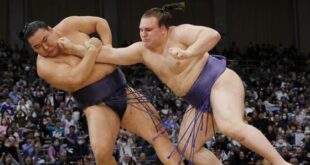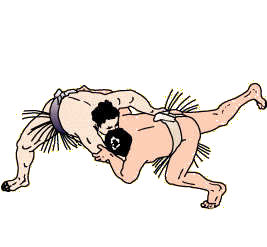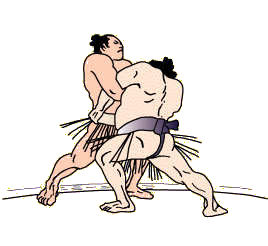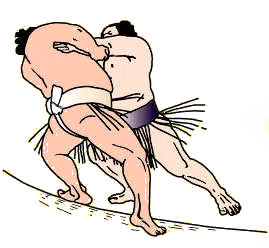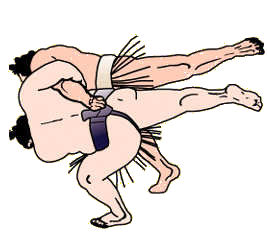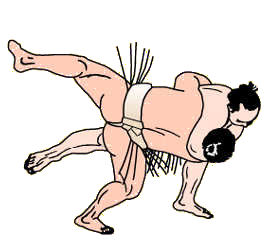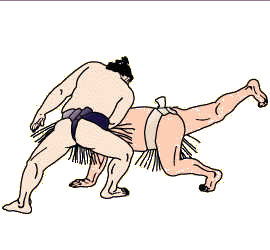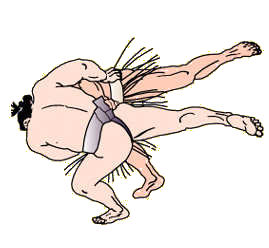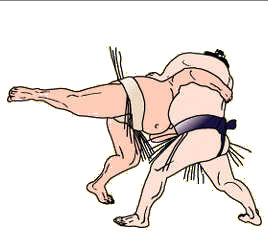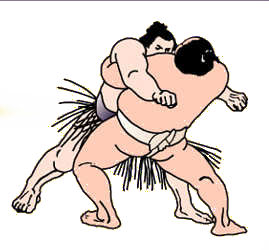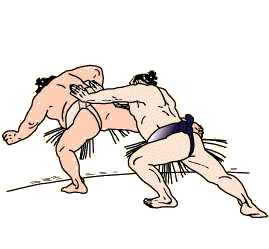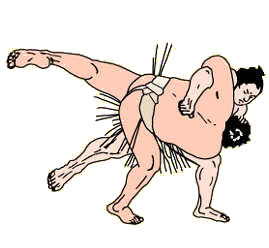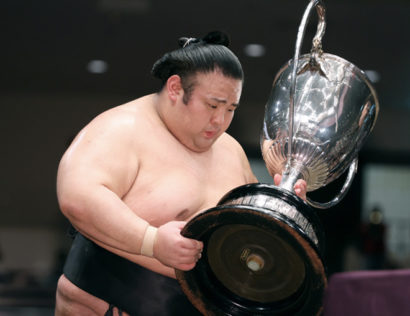
Un kettei-sen pour le vainqueur !
En ce dernier jour de tournoi, tout le monde attendait la scène finale qui délivrerait la Coupe de l’Empereur au vainqueur.
En pôle position avec 13 victoires, l’ôzeki Takakeishô , seul survivant des 5 rikishi du haut du banzuke : les deux yokozuna, Hakuhô et Kakuryu, ainsi que les deux autres ôzeki, Asanoyama et Shodai, avaient abandonné, laissant la voie libre à leur collègue.
Juste derrière lui, le komusubi Terunofuji le talonnait avec 12 victoires. Le mongol est l’auteur d’une « remontada » impressionnante après sa blessure en 2019. Parti du rang Makushita 10 en Novembre de l’an dernier, il est progressivement remonté en 2020 en Juryô 13, raflant la victoire finale dans cette catégorie, puis J3, avant de se retrouver en Maegashira 17 en juillet dernier et d’empocher la coupe de l’Empereur ! Il a continué ensuite remontant en Maegashira 1 puis en komusubi en Novembre. Et là, il lui suffit maintenant de vaincre une première fois Takakeishô pour être de nouveau en position de prétendant au Yushô.
Inutile de dire que ce dernier combat était le plus attendu de la journée ! Le tachi-ai fut brutal, les deux lutteurs ayant mis toute leur énergie à démolir leur adversaire. Après quelques assauts et une dérobade de Takakeishô qui faillit déséquilibrer Terunofuji, ce dernier réussissait à se rapprocher de l’ôzeki et à mettre les mains sur son mawashi. Ce faisant, il le décolla avant de le basculer au sol sous les acclamations du public ! C’était désormais le kettei-sen (match de play-off) qui séparerait les deux rikishis pour la victoire finale.
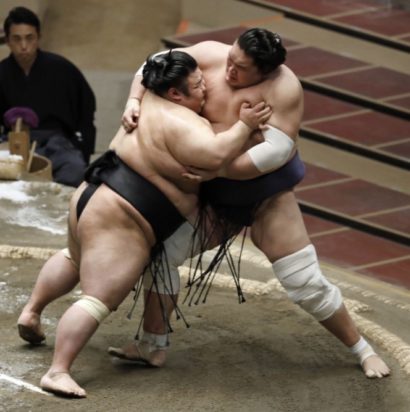
Mais lors du deuxième combat, Terunofuji n’a pas su retrouver la même « gnaque » que juste avant. Avec un bien meilleur tachi-ai, Takakeishô a pris tout de suite l’ascendant, forçant son adversaire à se relever puis à reculer jusqu’au bord du cercle sacré !
« Je n’aurais pas pu gagner tout seul. J’ai pu y parvenir grâce à mon maître d’écurie Chiganoura, à sa femme et à toutes les personnes qui me soutiennent à l’écurie », a déclaré Takakeisho. « Ce résultat me rend très heureux. Depuis que j’ai été promu ozeki, il ne m’est pas arrivé beaucoup de bonnes choses. Je savais que je devais affronter mentalement la tempête »
De son côté, Terunofuji est bien sûr très déçu :
« Mes mauvaises habitudes sont revenues sur le dernier combat. Mon buste s’est redressé trop haut. Avant ce tournoi, je visais un score de victoires à deux chiffres. J’ai donc atteint mon objectif, mais là encore, je suis tombé juste avant le gain du championnat. »
Chez les autres lutteurs, les deux sekiwake ont tous les deux perdus leur dernier combat, sans conséquence pour Takanosho qui avait déjà sa 8ème victoire en poche, mais plus embêtant pour Mitakeumi qui descendra d’un rang dans le prochain classement avec seulement 7 victoires.
Le deuxième komusubi Takayasu s’en est très bien sorti contre Tamawashi (M6), et a enfin remporté sa 8ème victoire.
Tout au fond, le poids léger Enho (M11) a réussi une 3ème victoire inespérée contre le maegashira 4 Tobizaru, mais redescendra lui aussi dans les profondeurs prochain du classement.
En juryô, c’est un autre poids léger, le surprenant Midorifuji (114 kg), qui a atteint le kettei-sen contre Kyokushuho, et qui l’a sorti brillamment, remportant ainsi son premier titre dans cette catégorie. Midorifuji sera makuuchi au prochain tournoi !
Les lutteurs kachi koshi du jour sont :
Jûryô : Azumaryu, Chiyootori, Wakamotoharu, Daishomaru, Kyokutaisei
Les lutteurs make koshi du jour sont :
Jûryô : Hidenoumi
Clic on the title bellow for article in English :
Takakeisho wins 2nd title after beating Terunofuji in playoff
Takakeisho claimed his second Emperor’s Cup by defeating title rival Terunofuji in a championship playoff at the November Grand Sumo Tournament on Sunday.
The 24-year-old ozeki was unable to seal the championship in the final scheduled bout of the 15-day tournament against komusubi Terunofuji, who earned a shot at a playoff victory after forcing down Takakeisho and drawing level at 13-2. Having held his ground against Takakeisho’s powerful thrusting attack, Terunofuji almost succumbed to a slap down but kept his footing before wrapping up the ozeki and dumping him to the clay. But Takakeisho showed strong resolve in the playoff and stuck to his tried-and-tested techniques. Hitting hard and low from the jump, he denied Terunofuji a belt grip before pushing him back and out.
Takakeisho had carried the mantle of title favorite as the highest-ranked wrestler left at the tournament, which was moved to Tokyo’s Ryogoku Kokugikan from its usual home in Fukuoka to limit the spread of the novel coronavirus.
Injuries forced the withdrawal of grand champions Hakuho and Kakuryu before the meet, while ozeki Asanoyama and Shodai pulled out in the early stages.
The championship is Takakeisho’s first captured while fighting from sumo’s second-highest rank. He won his maiden Emperor’s Cup at the 2018 Kyushu Grand Tournament as a komusubi.
« I couldn’t have won by myself. I was able to achieve this thanks to my stablemaster Chiganoura, his wife, and all the people that support me at the stable, » said Takakeisho, who has struggled with injury since his ozeki debut in May last year.
« This result makes me very happy. Ever since I was promoted to ozeki, not many good things have happened to me. I knew I had to mentally weather the storm. »
The runner-up finish continues a remarkable comeback story for 28-year-old former ozeki Terunofuji, who won the July tournament in his return to the top flight following multiple knee surgeries and a long climb back from sumo’s fifth division.
The 173-kilogram wrestler, who possesses a rare combination of size and skill, lost out on his third Emperor’s Cup but picked up Technique Prize.
« My bad habits emerged (in the playoff). My upper body came up too high, » said Terunofuji. « Before this tournament, I was aiming for double-digit wins. So I achieved my goal, but then again, I came so close (to the championship). »
Sekiwake Takanosho (8-7) ended a solid debut in the elite « sanyaku » ranks below yokozuna with a slap-down loss to a former ozeki, No. 7 Tochinoshin (9-6).
Sekiwake Mitakeumi (7-8) broke a six-match losing streak by thrusting down No. 6 Takarafuji (9-6), who buckled quickly following a shaky initial charge.
Komusubi Takayasu claimed a winning record at 8-7 by forcing out No. 6 Tamawashi (8-7). The former ozeki got a firm hold of Tamawashi’s belt at the jump and drove him straight out.
Among the rank and file, No. 7 Endo (8-7) secured a crucial eighth victory against No. 13 Hoshoryu, who finished one win short of the benchmark at 7-8.
No. 14 Chiyonokuni improved to 10-5 and snared a Fighting Spirit Prize in his makuuchi comeback tournament with an arm-lock throw victory over No. 9 Kotoeko (6-9).
« I could never have done it without the support of so many people, » said the 30-year-old Chiyonokuni, who had fallen to the third-tier makushita division following a knee injury.
No. 17 Shimanoumi also earned a Fighting Spirit Prize after emerging as an unlikely title contender during the tournament. He finished at 11-4 following a loss to No. 10 Meisei (9-6).
Towering No. 13 Ichinojo clinched a winning record at 8-7 after toppling No. 16 Chiyoshoma (8-7). The former sekiwake, fighting at a trimmed-down 198 kg, has compiled two straight winning tournaments after climbing back from the juryo division.
Source : Kyodo
Champions par division :
Makuuchi : Takakeisho (13-2)
Ôzeki – Chiganoura beya
Jûryô : Midorifuji (10-5)
Est 2 – Isegahama beya
Makushita : Ryuko (7-0)
Ouest 15 – Onoe beya
Sandanme : Hokuseiho (7-0)
Est 21 – Miyagino beya
Jonidan : Ofukasawa (7-0)
Ouest 6 – Naruto beya
Jonokuchi : Nogami (7-0)
Est 29 – Oguruma beya
Prix spéciaux (sanshô) :
Shukun-shô : pas de prix attribué
Performance exceptionnelle
Kantô-shô : Chiyonokuni (2e), Shimanoumi (2e)
Meilleur esprit combatif
Ginô-shô : Terunofuji (2e)
Prix de la technique
Prochain rendez-vous : Hatsu basho 2021
- Parution du banzuke : 24 Décembre 2020
- Début du tournoi : 10 Janvier 2021
- Fin du tournoi : 24 Janvier 2021
Lieu : Tokyo (Ryogoku Kokugikan)
Merci à tous d’avoir suivi le tournoi jour après jour sur Dosukoi mais l’actualité du sumo continue même en dehors des basho. Toutes les informations des événements à venir sont sur notre site. N’oubliez pas de nous rejoindre sur les réseaux sociaux, suivez-nous sur Facebook et Twitter et abonnez-vous à notre chaîne YouTube. N’hésitez pas à partager les articles sur ces réseaux et à les commenter.
Enfin, merci à Sumo Natto et Kintamayama pour leurs vidéos quotidiennes ainsi qu’à tous nos lecteurs.
- Makuuchi
- Juryô
|
Rikishis
|
Score
|
Kimarites
|
Score
|
Rikishis
|
 Chiyoshoma
千代翔馬 (Maegashira 16) |
|
|
|
|
 Ichinojo
逸ノ城 (Maegashira 13) |
|
 Sadanoumi
佐田の海 (Maegashira 11) |
|
|
|
|
 Ishiura
石浦 (Juryo 3) |
|
 Shimanoumi
志摩ノ海 (Maegashira 17) |
|
|
|
|
 Meisei
明生 (Maegashira 10) |
|
 Chiyonokuni
千代の国 (Maegashira 14) |
|
|
|
|
 Kotoeko
琴恵光 (Maegashira 9) |
|
 Tokushoryu
徳勝龍 (Maegashira 9) |
|
|
|
|
 Akua
天空海 (Maegashira 16) |
|
 Kaisei
魁聖 (Maegashira 12) |
|
|
|
|
 Terutsuyoshi
照強 (Maegashira 8) |
|
 Aoiyama
碧山 (Maegashira 8) |
|
|
|
|
 |
|
 Hoshoryu
遠藤 (Maegashira 13) |
|
|
|
|
 Endo
遠藤 (Maegashira 7) |
|
 Enho
炎鵬 (Maegashira 11) |
|
|
|
|
 Tobizaru
翔猿 (Maegashira 4) |
|
 |
|
|
|
|
 Ryuden
竜電 (Maegashira 10) |
|
 Kagayaki
輝 (Maegashira 3) |
|
|
|
|
 Yutakayama
豊山 (Maegashira 12) |
|
 Kotoshoho
琴勝峰 (Maegashira 5) |
|
|
|
|
 Daieisho
大栄翔 (Maegashira 2) |
|
 Onosho
阿武咲 (Maegashira 2) |
|
|
|
|
 Myogiryu
妙義龍 (Maegashira 5) |
|
 Kotonowaka
琴ノ若 (Maegashira 14) |
|
|
|
|
 Wakatakakage
若隆景 (Maegashira 1) |
|
 Kiribayama
貴ノ富士 (Maegashira 1) |
|
|
|
|
 Okinoumi
隠岐の海 (Maegashira 3) |
|
 Tamawashi
玉鷲 (Maegashira 6) |
|
|
|
|
 Takayasu
高安 (Komusubi) |
|
 Tochinoshin
栃ノ心 (Maegashira 7) |
|
|
|
|
 Takanosho
隆の勝 (Sekiwake) |
|
 |
|
|
|
|
 Takarafuji
宝富士 (Maegashira 6) |
|
 |
|
|
|
|
 Terunofuji
照ノ富士 (Komusubi) |
KETTEI-SEN
 |
|
|
|
|
 |
|
Rikishis
|
Score
|
Kimarites
|
Score
|
Rikishis
|
 Takagenji
貴源治 (Juryo 12) |
|
|
|
|
 Terasawa
(Makushita 4) |
|
 Ura
(Juryo 13) |
|
|
|
|
 Ikioi
勢 (Juryo 8) |
|
 Jokoryu
常幸龍 (Juryo 12) |
|
|
|
|
 Azumaryu
東龍 (Juryo 7) |
|
 Chiyootori
千代鳳 (Juryo 7) |
|
|
|
|
 Hakuyozan
白鷹山 (Juryo 10) |
|
 Chiyonoumi
千代の海 (Juryo 14) |
|
|
|
|
 Wakamotoharu
(Juryo 6) |
|
 Daishomaru
大翔丸 (Juryo 9) |
|
|
|
|
 Hidenoumi
英乃海 (Juryo 5) |
|
 Daiamami
大奄美 (Juryo 5) |
|
|
|
|
 Fujiazuma
(Juryo 14) |
|
 Nishikifuji
錦富士 (Juryo 13) |
|
|
|
|
 Nishikigi
錦木 (Juryo 4) |
|
 Chiyomaru
千代丸 (Juryo 4) |
|
|
|
|
 Kyokutaisei
旭大星 (Juryo 8) |
|
 Churanoumi
美ノ海 (Juryo 6) |
|
|
|
|
 Shôhôzan
松鳳山 (Juryo 2) |
|
 Midorifuji
翠富士 (Juryo 2) |
|
|
|
|
 Kyokushuho
旭秀鵬 (Juryo 10) |
|
 Mitoryu
水戸龍 (Juryo 11) |
|
|
|
|
 Chiyonoo
千代ノ皇 (Juryo 1) |
|
 Akiseyama
明瀬山 (Juryo 1) |
|
|
|
|
 Tsurugisho
剣翔 (Juryo 9) |
KETTEI SEN
 |
|
|
|
|
 |
 Dosukoi, le site du sumo Sumo : actualités, résultats, dossiers, vidéos… toute la passion du sumo est sur Dosukoi!
Dosukoi, le site du sumo Sumo : actualités, résultats, dossiers, vidéos… toute la passion du sumo est sur Dosukoi!

